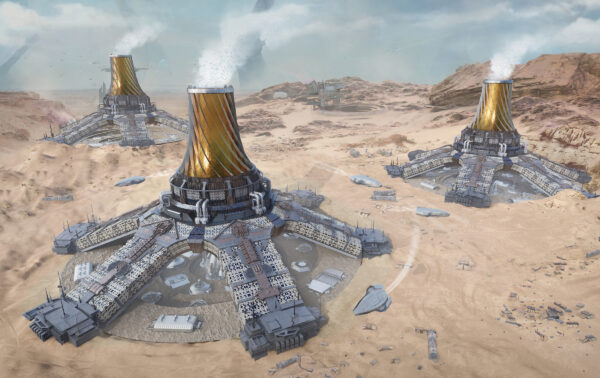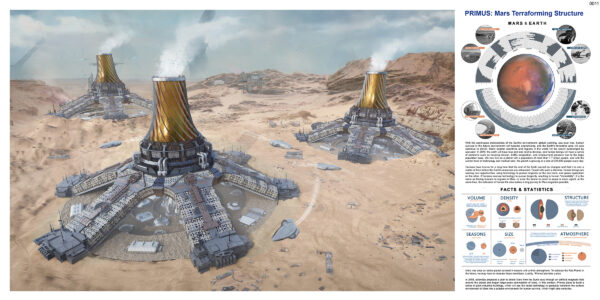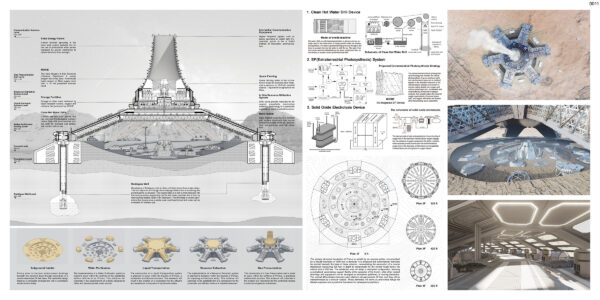Honorable Mention
2023 Skyscraper Competition
Siyuan Liu, Yuchen Jin
China, United States
Where is the future shelter of humanity?
The ongoing degradation of the terrestrial environment, manifested by the pernicious effects of global warming and the rise in sea levels, has presented a formidable challenge to human survival on our planet. The shrinkage of terrestrial areas, consequent to the inundation of coastal regions, compounds this pressing issue. In light of this impending crisis, humanity has been forced to contemplate alternative avenues for securing its future, including the augmentation of life expectancy and the pursuit of extraterrestrial habitation.
Mars, with its aura of romanticism and enigmatic character, has become the subject of scholarly interest and a viable target for colonization. The hypothesis of terraforming the Red Planet into a hospitable environment for human life, however, remains a matter of contention, given the lack of concrete evidence supporting its feasibility. Nevertheless, the prospect of colonizing Mars constitutes a potential strategy for mitigating the risks posed by the changing environmental conditions on Earth and ensuring the continuation of human civilization in the face of uncertainty.
Mars Terraforming Structure: “Primus”
The planet Mars, once characterized by its oceans, thick atmosphere, and geological activity, has been a subject of fascination for scientists and space enthusiasts alike. In 2458, a seminal proposal was advanced, positing the creation of an artificial magnetic field around the Red Planet as a means of shielding it from the detrimental effects of solar radiation. This ambitious plan, referred to as “Primus,” envisions the establishment of massive industrial structures that will utilize state-of-the-art technology to gradually modify the Martian environment over several centuries, so as to render it hospitable to human habitation.
The central architecture of Primus consists of six monumental columns that support its primary structure. The interior space beneath the system is envisaged as a habitat that will provide living quarters for Mars’ inhabitants. The residential area will have a centripetal arrangement, with a comprehensive service facility located at the center and general living pods and equipment situated on circular platforms of varying diameters. These habitats will provide initial accommodation for Martian explorers, as well as the necessary infrastructure for continued exploration and eventual expansion.
Extraterrestrial Photosynthesis Technology
The Rodriguez Well technology represents a means of exploiting the subglacial regions of Mars through the utilization of a continuous process of heating and recirculation of water, resulting in the formation of a substantial body of liquid water. The subsequent extraction of a portion of this water is accomplished through a system of siphoning. In light of the objective of ensuring extraterrestrial survival, the concept of Extraterrestrial Photosynthesis (EP) has been proposed, centered around the conversion of CO2/H2O into fuel and O2, the former being procured from the waste CO2 in spacecraft or the ambient CO2 in extraterrestrial environments, such as Mars.
It is estimated that Primus will discharge oxygen and carbon dioxide into the Martian atmosphere at an annual rate of 95,000 tons, thereby leading to a gradual increase in atmospheric pressure over a period of 100 years to surpass 24 kPa. When the atmosphere of Mars becomes predominantly composed of CO2, a potent greenhouse gas, the onset of heating will be facilitated, due to the insulating effect of CO2. Additionally, as the temperature continues to rise, it is expected that a greater quantity of CO2 will be released from the frozen reserves at the poles, thereby intensifying the greenhouse effect. By the 200th year, it is plausible that the atmospheric composition of Mars will have been altered to the extent that it will serve as a viable secondary habitat for humankind.

















